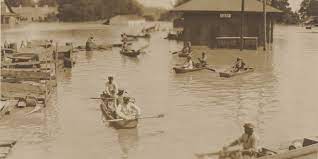The Great Mississippi Flood of 1927 was one of the most destructive and devastating natural disasters in American history, affecting millions of people in the United States and causing widespread destruction along the Mississippi River and its tributaries. The flood, which occurred in the spring of 1927, was the result of heavy rainfall and snowmelt in the Mississippi River basin, leading to record-high water levels and catastrophic flooding that inundated towns, cities, and farmland throughout the region. The Great Mississippi Flood of 1927 was a humanitarian crisis of epic proportions, displacing hundreds of thousands of people from their homes and causing immense suffering and loss. The floodwaters submerged vast areas of land, destroying crops, livestock, homes, and infrastructure, and disrupting the lives of countless individuals and families. The scale and scope of the disaster were unprecedented, with the floodwaters spreading across more than 27,000 square miles and affecting 10 states along the Mississippi River and its tributaries. The impact of the Great Mississippi Flood of 1927 was felt most acutely in the Mississippi Delta region, a low-lying area known for its fertile soil and agricultural productivity. The floodwaters overwhelmed levees and other flood control structures, causing massive breaches and inundating the Delta with water. Entire communities were submerged, and thousands of residents were forced to flee their homes in search of higher ground. The floodwaters lingered for weeks, exacerbating the devastation and making rescue and relief efforts challenging. The response to the Great Mississippi Flood of 1927 was a testament to the resilience and solidarity of the American people in the face of disaster. Local communities, volunteers, and relief organizations mobilized to provide assistance to flood victims, offering shelter, food, medical care, and other forms of support to those affected by the disaster. The American Red Cross, the Salvation Army, and other relief agencies played a crucial role in coordinating relief efforts and providing aid to flood survivors. The Great Mississippi Flood of 1927 also had far-reaching social and political implications that reverberated throughout the country. The flood exposed deep-seated inequalities and injustices in American society, as African American communities and sharecroppers in the Mississippi Delta were disproportionately affected by the disaster. Many African American families were left stranded on levees and rooftops, facing discrimination and neglect in the distribution of relief supplies and services. The flood laid bare the racial disparities and systemic injustices that plagued the South and fueled calls for social and economic reform. The federal government's response to the Great Mississippi Flood of 1927 was a defining moment in the history of disaster relief and public policy in the United States. President Calvin Coolidge, facing mounting pressure to address the crisis, authorized the deployment of federal troops to assist with rescue and relief operations in the flood-affected areas. The U.S. Army Corps of Engineers was tasked with repairing levees and flood control infrastructure to prevent future flooding and mitigate the impact of the disaster.
1927 United States Great Mississippi Flood
